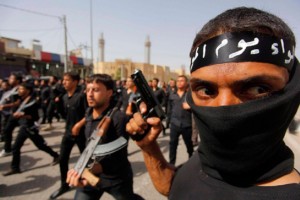ISIS-led anti-government Sunni Islam coalition troops have virtually surrounded Baghdad. Iraq’s largest province, al-Anbar, is almost totally occupied by anti-regime forces. Only a portion of Fallujah remains outside of occupation by the ISIS-led resistance. Following enemy takeover of Hit, regular Iraqi units fell back into a defensive posture at al-Asad, the largest military facility in Anbar. Several key population centers to the north and northeast have also fallen. Enemy gains last month north of Baghdad prompted U.S. aircraft bombing sorties previously unnecessary to the north. Since June, the central government also has lost ground east of the capital, with Diyala Province barely remaining under Shia control.[1] After the collapse of government forces in Hillah, south of the capital and the enemy’s mid-June seizures of Iskandariyah and Mahmoudiyah, barely six miles south of the Baghdad, routes to Iraq’s Shia heartland now also have been jeopardized.[2]
While the fall of the capital is certainly not imminent, the ISIS-led enemy’s strategy appears clear. Opposition forces will likely continue to tighten the noose around Baghdad in an attempt to create a sense of isolation. ISIS will avoid, for now, any large-scale assault on Baghdad for three principal reasons: it does not have the manpower; Shia militias outnumber enemy forces and will fight zealously to keep the Shia in control of the capital; and a major attack might cause remaining U.S. troops to become actively involved in the conflict. An indicator that American forces might join the fight, if such a scenario developed, was the Pentagon decision on 12 October to employ Apache Attack helicopters against ISIS forces when they approached Baghdad International Airport.[3] Fighting came within two miles west of the capital, with Sunni forces taking Abu Ghraib.
The ISIS-led Sunni coalition appears determined to inculcate a feeling of despair among the capital’s Shia citizenry. The daily suicide bombing attacks in Shia neighborhoods must be taking a psychological toll. The suicide bombers are foreign fighters, mostly hailing from North Africa.[4] They have killed hundreds of Shia citizens in the past few months. The operational planners of these assaults know the layout of the capital which may suggest that they are former Baath Party military officers under Saddam. Roadside bombs and car bombs have added to the sense that the security situation in the capital is spiraling out of control. Moreover, there can be little doubt that some within the Sunni neighborhoods are giving logistical and intelligence support to the encircling enemy. This certainly appears to be the case in the 14 October pinpoint targeted killing of Baghdad’s pro-Iranian Chief of the Badr Brigade, Ahmad al-Khafaji. Additional pro-Sunni elements probably have established a network of safe houses to support enemy infiltrators.
The day that the fate of Iraq as a united state irrevocably turned toward disintegration was in December 2013, when the largely Shia security forces stormed the Sunni protest camp in Anbar Province’s capital of Ramadi. Not even those tribal sheikhs who may have hoped for reconciliation with the Shia-led regime could reverse the process of permanent alienation. Following al-Maliki’s fall from power, newly installed Prime Minister al-Abadi has fared no better. Moreover, he seemingly has even less influence within the governing Shia coalition than al-Maliki originally possessed. It appears that he has moved too slowly to reach out to Sunnis. Furthermore, with the barbarians at the gates of Baghdad, the new administration did not name a new Minister of Defense and Interior until 17 October.
The ultimate goal of the enemy’s siege strategy may be to create enough chaos in the capital city to cause a mass exodus of Baghdad’s Shia population southward to the Shia provinces of Najaf and Karbala, thus ceding Baghdad to the Sunni by default.
[1] Foreign Policy “Barbarians at the Gates of Baghdad” by Susannah George 21 October 2014
[2] Washington Times “Surrounded: Nightmare Scenario Unfolds as ISIL Takes Supply Routes” by Douglas Ernst 24 June 2014.
[3] ISIS Surrounds Baghdad on Three Sides, Blog Site Jim Hoft 17 June 2014.
[4] Threat Matrix: A Blog of the Long War, “Islamic State Suicide Bomber Kills Militia Leader in Baghdad” by Bill Roggio, 14 October 2014
